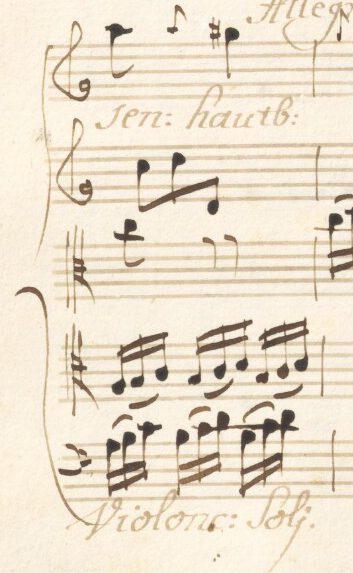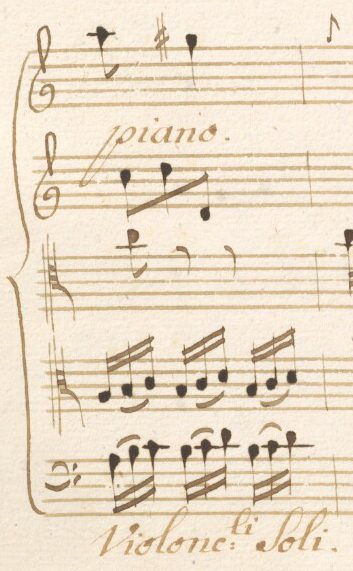Instrumentation
F. B. Conti's Penelope is scored for eight voices – with a clear focus on high voices – orchestra with strings and wind instruments, and basso continuo. With the exception of the divided viola part in the second part of the opening Sinfonia, the string ensemble has the usual instrumentation of two violins and viola, although the violins also play in unison in some arias. The continuo group consists of violoncellos, bassoon, double bass and harpsichord; other instruments such as a theorbo or viols may also have been used. In this composition, the winds (2 oboes, bassoon) do not have independent obbligato parts, but serve as reinforcement for the strings in the forte tutti passages: violin I and violin II were doubled by oboes, the continuo part additionally by the bassoon. From the instructions in the scores, which correlate, as well as other reference material, it can be concluded that the wind instruments only played during the instrumental parts, pausing during the vocal passages, so that the vocal part could always be heard well and be understandable. In order not to cover up the vocal parts, the strings are also instructed to play piano during the vocal sections. Where piano is marked during instrumental passages, it was intended that the should only be played by the strings, i.e. without oboes and bassoons.
The double bass also pauses during the vocal parts, but is involved in instrumental piano passages. The instructions “senza hautb:” [= senza hautbois = without oboes] and “piano” are therefore to be understood synonymously: As soon as piano is indicated, the winds have to pause unless an explicit instruction asks them to play along. “Forte” or ‘tutti’ implies that the wind instruments join the string instruments. The synonymous meaning of piano and “senza hautbois” can be clearly seen in a comparison of the instructions in the two score manuscripts in the Austrian National Library:


A-Wn Mus.Hs. 17110, fol. 7v (left), A-Wn Mus.Hs. 17226, fol. 7v (right)
On the basis of the instructions in the score and with knowledge of the implicit rules, the copyists then produced the individual parts for the instruments.
In Penelope, Conti avoids instrumental solos and largely dispenses with other solo instruments such as the chalumeau, theorbo, viola da gamba, flute or trumpet, which were available at the Viennese court but were often only used in one or very few arias of contemporary operas as instruments for a particular effect. Only in the aria of Tersite at the end of Act II is an additional instrument required – the two copies of the score preserved in the ÖNB give no indication of the instrumentation of the arpeggiated preludio, notated on two staves, or the solo part of the aria “Bravo! Bene!” notated on one staff. More specific information, however, is provided by the libretti with the scene instructions printed in brackets:

© Herzog August Bibliothek Wolfenbüttel; http://diglib.hab.de/drucke/textb-sbd-11-8s/start.htm
Tersite hears the sound of a salterio, or “pantaleon”. The Viennese court had a virtuoso working in the chapel, Maximilian Hellmann, who had been specially trained in Dresden. In the absence of a suitable or generally known German term, “Salterio” was rendered as “harp” in the contemporary translation of the libretto, which could also be used as a substitute for a salterio.
As the wind parts and the double bass only have a doubling function, the parts copied for them were often not kept but discarded over time in order to save space. For this reason, only the string parts – violin I, violin II, viola and violoncello – have been preserved for Penelope. As a result, the changes of instrumentation have to be reconstructed in many instances in the edition, as they are not explicitly and reliably notated at every place in the score copies.
These principles, which are only alluded to in the scores because they were generally known at the Viennese court, result in a differentiation in regard to dynamics, scoring and timbre, emphasizing the musical structure based on contrasts and alternations between instrumental and vocal parts. The specific instrumentation is not part of the compositional structure, but part of the performance practice: variable to a certain degree, it can be adapted to the particular performance conditions, such as the size of the room, the acoustics, the strength of the vocal parts and the available instruments.
Literature
Dagmar Glüxam, Instrumentarium und Instrumentalstil in der Wiener Hofoper zwischen 1705 und 1740 (Publikationen des Instituts für österreichische Musikdokumentation 32), Tutzing 2006.




